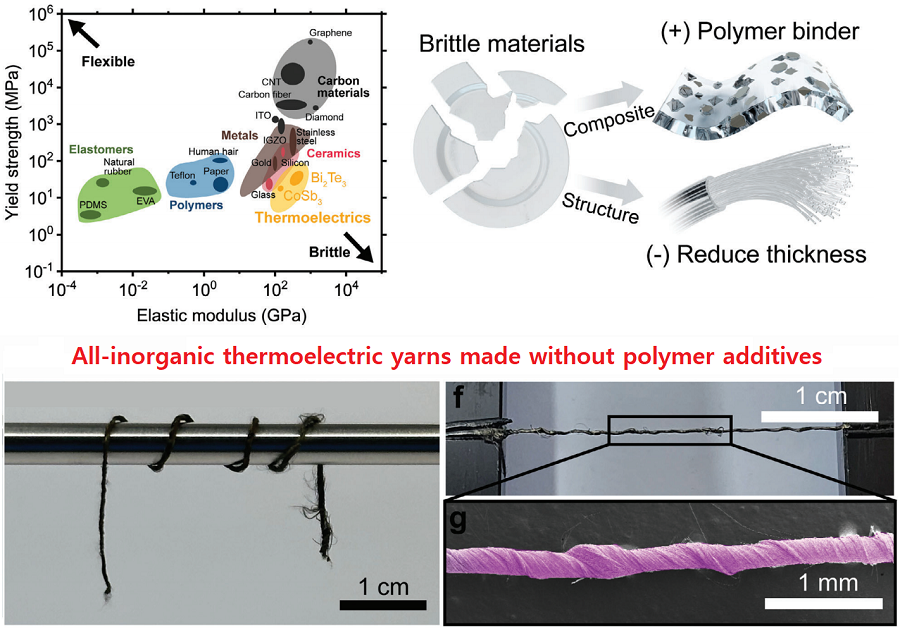A joint research team led by Professors Yeon Sik Jung and Inkyu Park, along with teams from Hanbat National University and the Korea Institute of Machinery and Materials, has successfully created "bismuth telluride (Bi2Te3) thermoelectric fibers." This innovative energy harvesting solution is designed for next-generation flexible electronic devices, as detailed in a study published in Advanced Materials.

Schematic diagram and actual image of the all-inorganic flexible thermoelectric yarn made without polymer additives. Image Credit: Korea Advanced Institute of Science & Technology
A group of Korean researchers has created a thermoelectric material that can be utilized in wearable technology, including smart clothing, and retains consistent thermal energy performance even in harsh conditions.
In addition to demonstrating the potential for commercialization, it has significantly ended the long-standing problem in thermoelectric materials: finding a balance between mechanical flexibility and maintaining good performance.
Thermoelectric materials transform thermal energy into electrical energy and produce voltage in response to temperature changes. Since roughly 70 % of energy is currently lost as wasted heat, research into sustainable energy materials that can recover and harvest energy from this waste heat is receiving due attention.
Most heat sources in the environment are curved, including cooling fins, vehicle exhaust pipes, and the human body. Ceramic materials derived from inorganic thermoelectric materials have high thermoelectric performance but are fragile, and it is challenging to create them in curved shapes.
Flexible thermoelectric materials utilizing existing polymer binders can be added to surface areas of numerous shapes; however, the polymer's high thermal resistance and low electrical conductivity limit performance.
While existing flexible thermoelectric materials contain polymer additives, the research team's inorganic thermoelectric material is not flexible. To overcome this, they twisted nanoribbons in place of additives to create a thread-shaped thermoelectric material.
Inspired by the flexibility of inorganic nanoribbons, the research team created Bi2Te3 inorganic thermoelectric fibers by continuously depositing nanoribbons using an electron beam deposition technique based on a nanomold and twisting them into a thread.
Even after more than 1,000 bending and tensile tests, these inorganic thermoelectric fibers demonstrated nearly no change in electrical properties and higher bending strength than current thermoelectric materials. The research team’s thermoelectric device uses temperature differences to generate electricity. If clothing is made with fiber-type thermoelectric devices, body temperature can generate electricity to power other electronic devices.
A demonstration of gathering energy by integrating thermoelectric fibers into clothing or life jackets demonstrated the viability of commercialization. It made it possible to construct a high-efficiency energy harvesting system that recycles waste heat in industrial settings by using the temperature differential between the cold air outside and the hot fluid inside a pipe.
The inorganic flexible thermoelectric material developed in this study can be used in wearable devices such as smart clothing, and it can maintain stable performance even in extreme environments, so it has a high possibility of being commercialized through additional research in the future. This technology will become the core of next-generation energy harvesting technology, and it is expected to play an important role in various fields from waste heat utilization in industrial sites to personal wearable self-power generation devices.
Yeon Sik Jung, Professor, Korea Advanced Institute of Science & Technology
This study was published in the online edition of the international academic journal Advanced Materials on September 17, 2024, and was chosen as the back-cover paper in recognition of its excellence.
Hanhwi Jang, a Ph.D. student at KAIST’s Department of Materials Science and Engineering, Professor Junseong Ahn of Korea University, Sejong Campus, and Dr. Yongrok Jeong of Korea Atomic Energy Research Institute all contributed equally as joint first authors.
The study was carried out with the support of the National Research Foundation of Korea’s Mid-career Researcher Support Program and the Future Materials Discovery Program, as well as the Global Bio-Integrated Materials Center, the Ministry of Trade, Industry and Energy, and the Korea Institute of Industrial Technology Evaluation and Planning (KEIT), which was funded by the Ministry of Science and ICT.
Journal Reference:
Jang, H. et. al. (2024) Flexible All-Inorganic Thermoelectric Yarns. Advanced Materials. doi.org/10.1002/adma.202408320